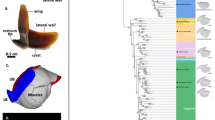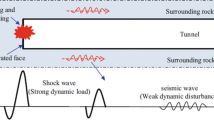Abstract
Underwater blasting, often known as submarine blasting, is used for a wide range of purposes. This includes harbor and channel widening, trench excavation for establishing oil and gas pipelines and communication cables, demolition operations, and substructure construction. Particularly, underwater rock blasting is the most difficult and least understood source of vibration, which may have a significant impact on the safety of neighboring buildings and structures, especially berthing structures. The main aim of the study is to design the blasting patterns and monitor the blast vibrations on substructures during real blasting. Furthermore, it is designed to monitor vibration movements and manage them in order to protect the coastal environments from the blasting effects and ensure the safety of various building structures, as well as to maintain the blasting efficiency. Dredging occurs in deep water, with depths ranging from 16 to 20 m, to remove only around 5 m of rock. As a result of the aqueous layer above the rock, this sort of blasting action demands a higher level of competence and understanding of the related activities performed above the surface of the water. The measuring and monitoring of underwater blast-generated vibration in the coastline structures at Nhava Sheva Port, Navi Mumbai, Maharashtra, were discussed in this study. When using underwater explosives, proper safety precautions are taken to protect workers, other vessels in the blasting zone, and buildings from blasting vibrations. With a case study, the authors provide a thorough overview of their approach to underwater blasting utilizing existing blasting technologies.








Similar content being viewed by others

References
Agrawal H, Mishra AK (2018) Evaluation of initiating system by measurement of seismic energy dissipation in surface blasting. Arab J Geosci 11:345. https://doi.org/10.1007/s12517-018-3683-3
Agrawal H, Mishra AK (2021) An analytical approach to measure the probable overlapping of holes due to scattering in initiation system and its effect on blast-induced ground vibration in surface mines. Min Metall Explor 38:485–495. https://doi.org/10.1007/s42461-020-00350-2
Chen F, He G, Dong S, Zhao S, Shi L, Liu X, Zhang B, Qi N, Deng S, Zhang J (2022) Space-time effect prediction of blasting vibration based on intelligent automatic blasting vibration monitoring system. Appl Sci 12:12. https://doi.org/10.3390/app12010012
Chen J, Gu W, Wang Z et al (2016) Field test and analysis on land and underwater vibration of underwater porous blasting in Yangshan Port. Vib Shock 35(24):207–212. https://doi.org/10.13465/j.cnki.jvs.2016.24.033
Chenyang MA, Li WU, Miao S (2016) Influence of free surface numbers on the energy distribution and attenuation of vibration signals of underwater drilling blasting. Explos Shock Waves 42(1):015201
Cooper HR (1958) Practical dredging and allied subjects, Brown, Son & Ferguson Ltd., Glasgow, 431, ASIN : B0000EGOQJ
CWPRS (1988) Technical Report No. 2947, Blast Studies Carried out at Nhava-Sheva Port for Safety of Caves at Elephanta Island, CWPRS Technical Report, pp. 15
Dehghani H, Babanouri N, Alimohammadnia F, Kalhori M (2020) Blast-induced rock fragmentation in wet holes. Mines Min Metall Explor 37:743–752
Directorate General of Mines Safety (DGMS) (1997) Circular Technical 7 of 1997. Directorate General of Mines Safety, India, Government of India—Ministry of Labour & Employment, pp 500–508
Domenico SN (1982) Acoustic wave propagation in air-bubble curtains in water; Part I. History and theory. Geophysics 47(3):345–353. https://doi.org/10.1190/1.1441340
Faulkner SG, Tonn WM, Welz M, Schmitt DR (2006) Effects of explosives on incubating lake trout eggs in the Canadian Arctic. N Am J Fish Manag 26(4):833–842. https://doi.org/10.1577/M05-132.1
Fletcher K, Briggs M, Grant R, and Cano ML (2004) Deep water blasting on the River Nile in Southern Egypt. In: Proceedings of the International Conference on Explosives and Blasting Techniques, 1:1–14
Gustafsson R (1973) Swedish blasting technique. Gothenburg, Sweden: SPI.323
Hagan TN (1983) The influence of controllable blast parameters on fragmentation and mining costs. In: Proceedings of the First International Symposium on Rock Fragmentation by Blasting, Rustan, A. and Homberg, R. (eds.), Lulea, Sweden, August 22- 26:31–52
Hamdi E, and Karrech A (2015) A methodology for rock mass characterisation to control blast-induced vibrations. In: Proceedings of 11th International Symposium on Rock Fragmentation by Blasting, 24–26, Sydney, Australia, 89–96
Hustrulid WA (1999) Blasting principles for open pit mining. Balkema, Rotterdam, p 1013
IS 14881 (2001): Method for blast vibration monitoring - Guidelines [CED 48: Rock Mechanics] Bureau of Indian Standards, New Delhi, p 12
Jimeno CL, Jimeno EL, Carcedo FJA and Ramiro YV (1995) Drilling and Blasting of Rocks, A.A. Balkema, Rotterdam, Brookfield, p 391
Langefors U, Kihlstrom B (1978) The modern technique of rock blasting. John Wiley and Sons, New York, NY, p 405
Liao X, Khandelwal M, Yang H, Koopialipoor M, Murlidhar BM (2020) Effects of a proper feature selection on prediction and optimization of drilling rate using intelligent techniques. Eng Comput 36:499–510. https://doi.org/10.1007/s00366-019-00711-6
Martin D (2015) Scientific evaluation of fauna sensitivity to blasting. In: Proceedings of 11th international symposium on rock fragmentation by blasting, 24–26 August 2015, Sydney, Australia, pp.519–526
Mohamad ET, Yi CS, Murlidhar BR, Saad R (2018) Effect of geological structure on flyrock prediction in construction blasting. Geotech Geol Eng 36:2217–2235
Monteros EH, Pascual JA (2003) Underwater blasting in Algeciras-Spain for the world biggest floating dock. In: Proceedings of EFEE Second World Conference on Explosives and Blasting Techniques, 10~12 September 2003, Prague, Explosives and Blasting Technique, Holmberg (ed.) Swets & Zeitlinger, Lisse, ISBN 90 5809 605:101–107
Piyush P, Rai P, Sharma SK (2021) Selection of blasting design parameters affecting peak particle velocity—A case study. Min Metall Explor 38:1435–1447
Roy MP, Paswan RK, Sarim MD, Kumar S, Jha R, Singh PK (2016) Rock fragmentation by blasting-A review. J Mines Metals Fuels 64(9):424–431
Sanchidrián JA, Ouchterlony F, Segarra P, Moser P (2014) Size distribution functions for rock fragments. Int J Rock Mech Min Sci 71:381–394
Scott A (1996) Blast ability and blast design, In: Mohanty B (ed), Fragblast 5. In: Proc 5th international symposium on rock fragmentation by blasting: Rotterdam: Balkema, pp 27–36
Sohn JM, Kim JW, Kim SH (2022) Experimental and numerical studies on fluid-structure interaction for underwater drop of a stone-breaking crusher. J Mar Sci Eng 10:30. https://doi.org/10.3390/jmse10010030
Sun Miao Wu, Li ZY et al (2019) Optimal noise reduction smoothing model for seismic wave signals of underwater drilling and blasting. J South Chin Univ Technol Nat Sci Edit 47(8):31–37. https://doi.org/10.12141/j.issn.1000-565X.180601
Tripathi GR, Shirke RR (2015) Underwater drilling and blasting for hard rock dredging in Indian ports - A case study, international conference on water resources, coastal and ocean engineering (ICWRCOE 2015). Aquat Proc 4:248–255
Tripathy GR, Gupta ID (2002) Prediction of ground vibration due to construction blasts in different types of rock- a technical note. J Rock Mech Rock Eng 35:195–204
Tsinidis G, Di Sarno L, Sextos A, Peter F (2019) A critical review on the vulnerability assessment of natural gas pipelines subjected to seismic wave propagation. Part 2: Pipe analysis aspects. Tunn Underg. Sp Tech. 92:103056. https://doi.org/10.1016/j.tust.2019.103056
Yuntian W, Xiangguo Z, Huayan C, Xin Y, Fang W, Zhongpeng Q (2021) Multi-scale simulation study on characteristics of free surface velocity curve in ductile metal spallation. Explos Shock Waves 41(8):084202. https://doi.org/10.11883/bzycj-2020-0467
Zhang LM, Zhao MS, Chi E, Huang B, He XG (2017) Experiments for effect of blasting vibration on underground pipeline and risk prediction. J Vibr Shock 36(16):2041–2247
Zhou J, Koopialipoor M, Bhatawdekar R, Fatemi SA, Tahir MM, Armaghani DJ, Li C (2019) Use of intelligent methods to design effective pattern parameters of mine blasting to minimize flyrock distance. Nat Resour Res 29(11):1–15
Acknowledgements
Thanks are due to Anna University, Chennai, and the Indian Institute of Technology (ISM), Dhanbad, for granting the necessary permission to publish the paper. Thanks are also due to Shri. R. Ramesh, RKS Drilling Services, Chennai, for rendering necessary assistance during the study.
Funding
The authors have not disclosed any funding.
Author information
Authors and Affiliations
Corresponding author
Ethics declarations
Conflict of interest
The authors declare that they have no conflict of interest.
Additional information
Publisher's Note
Springer Nature remains neutral with regard to jurisdictional claims in published maps and institutional affiliations.
Rights and permissions
Springer Nature or its licensor holds exclusive rights to this article under a publishing agreement with the author(s) or other rightsholder(s); author self-archiving of the accepted manuscript version of this article is solely governed by the terms of such publishing agreement and applicable law.
About this article
Cite this article
Balamadeswaran, P., Mishra, A.K., Manikanda Bharath, K. et al. Controlled blasting design for efficient and sustainable underwater excavation: art meets science!. Nat Hazards 114, 3701–3717 (2022). https://doi.org/10.1007/s11069-022-05539-w
Received:
Accepted:
Published:
Issue Date:
DOI: https://doi.org/10.1007/s11069-022-05539-w



